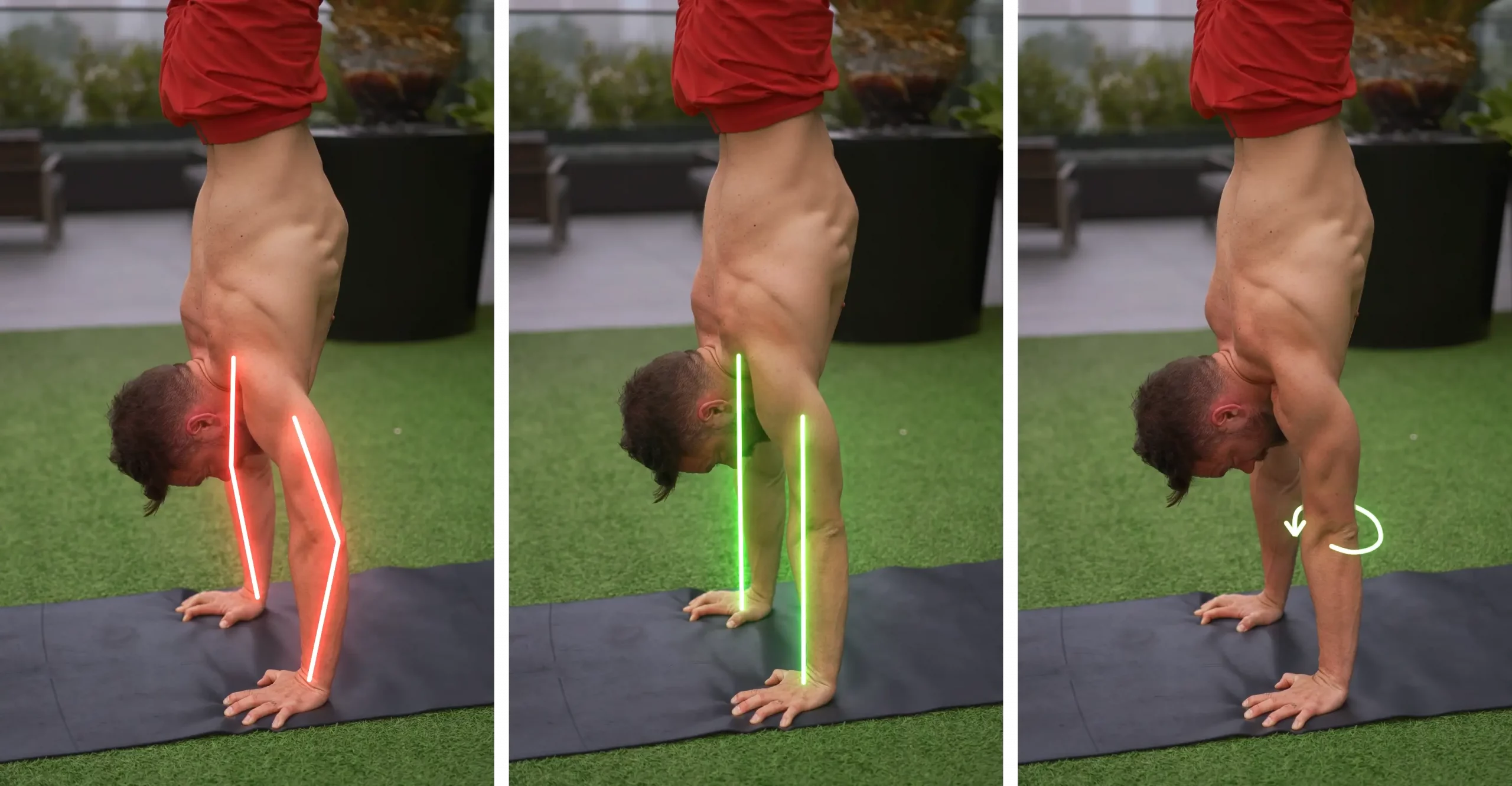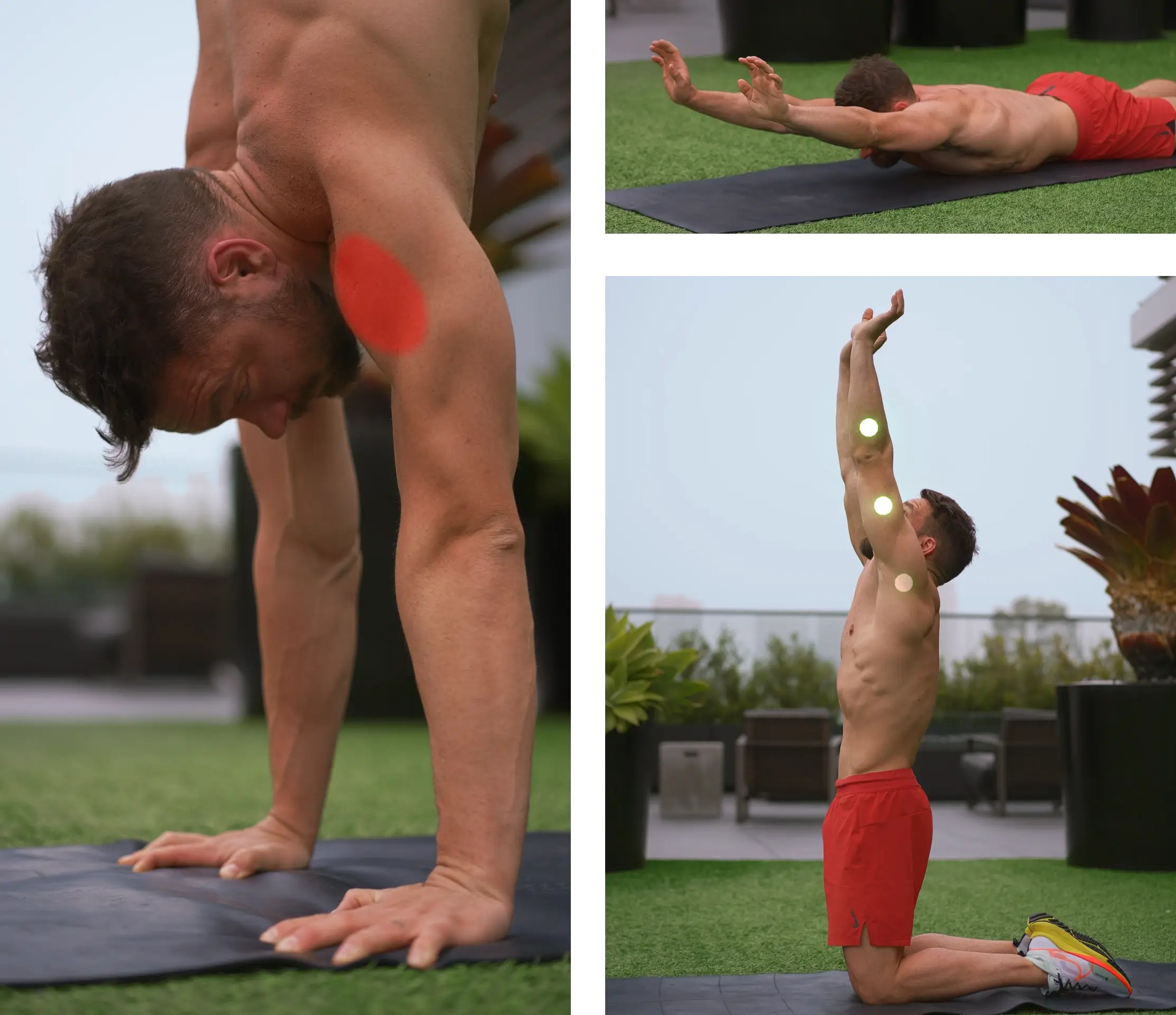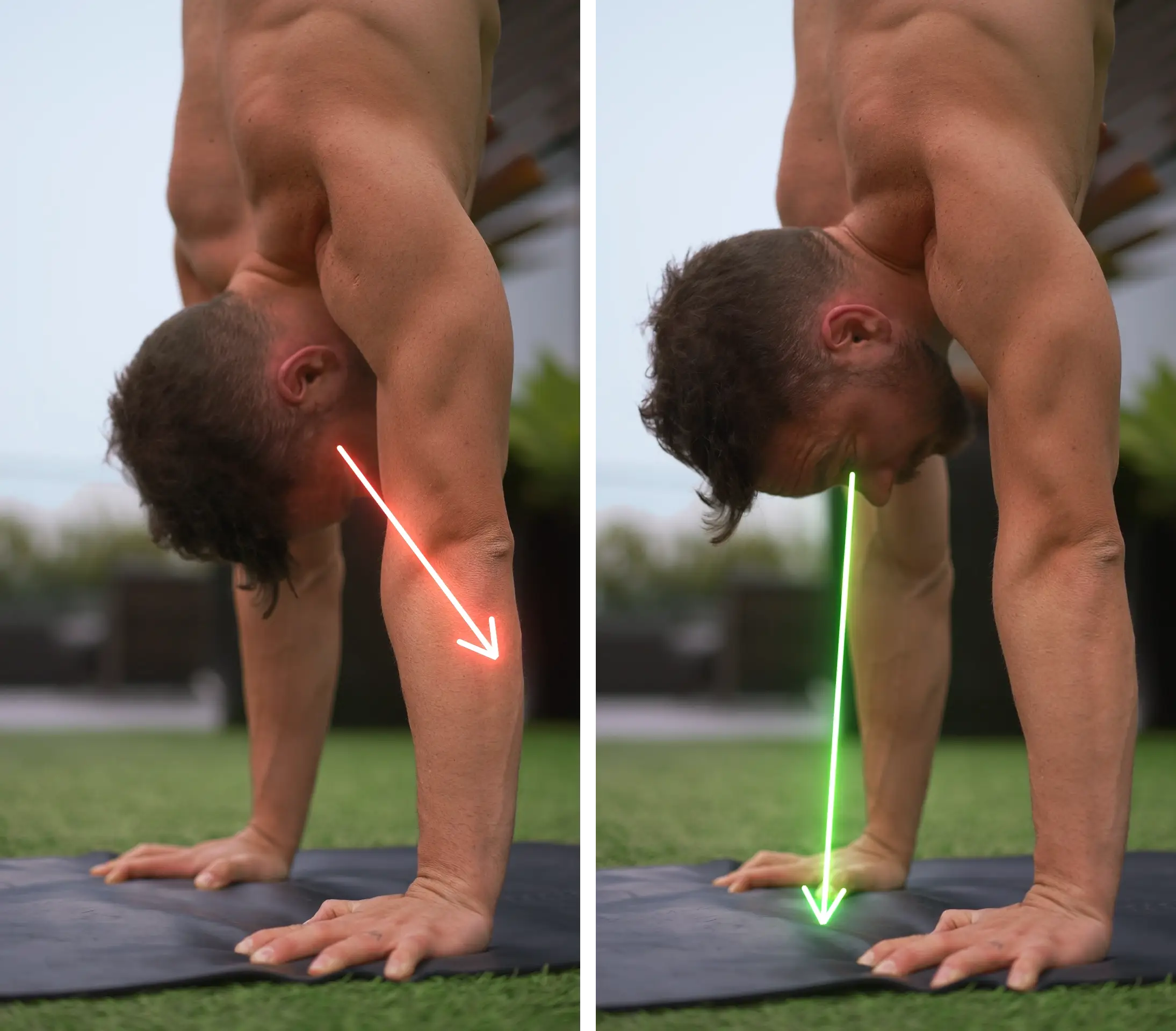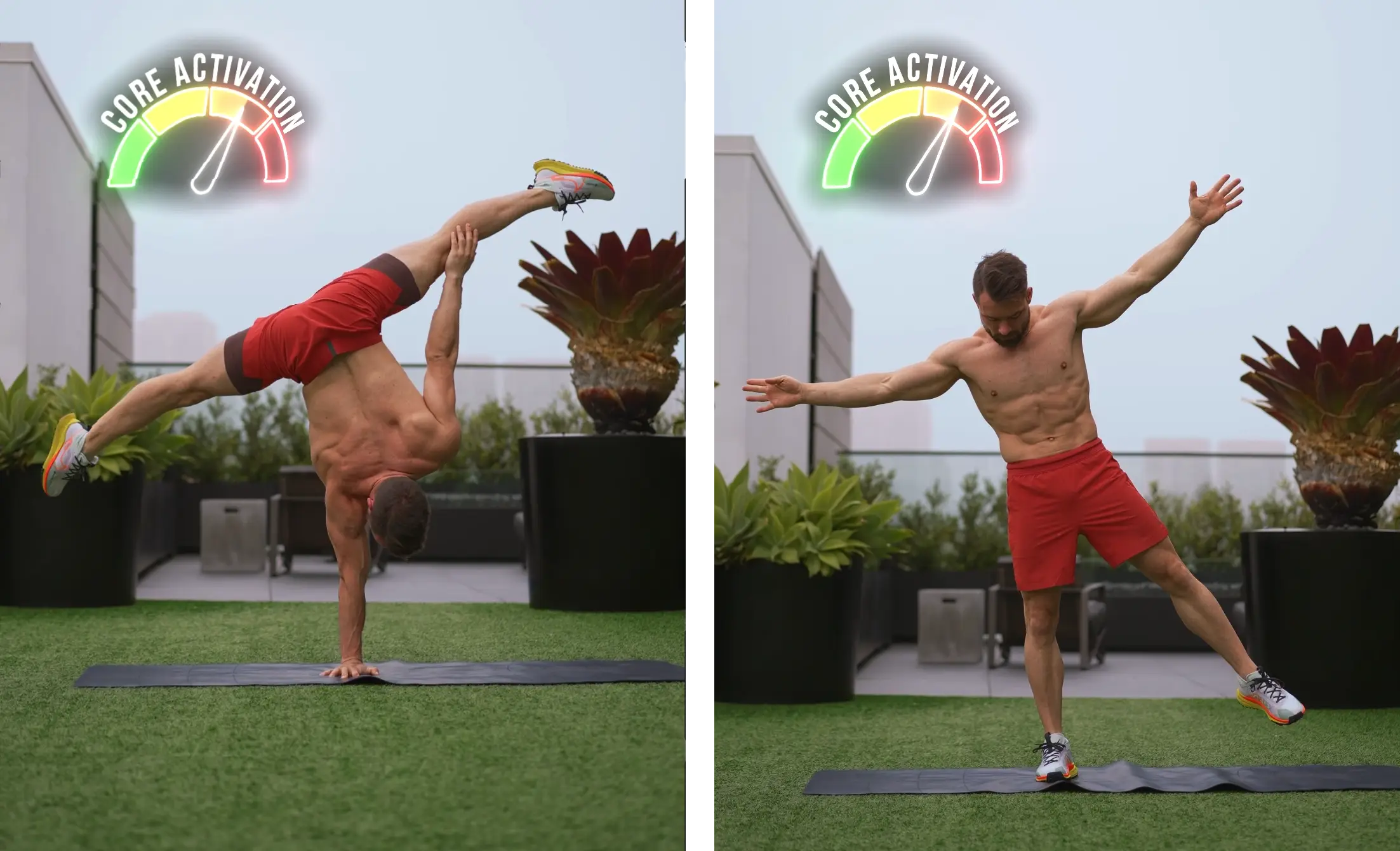Below
the shoulders
We are upside down so what used to be above now is below. We are talking about our arms. We stand on them now and our arms have just become legs.
The wrists
Your hands are your connection with the floor. They are your first line of control. If you start wonky here it can only get worse on the way up.
Your hands shoulder be shoulder wide apart and your fingers point towards the front.
Keep in mind that there is a lot happening inside of your wrists. There are plenty of small bones in not a lot of space. You need to be careful with your wrists and with working on them as there is only so much you can influence!

If you have stiff wrists like me you will have to mobilize more before getting upside down. You should make an effort in understanding why they are stiff. Is it due to muscles tension or because the little bones are grinding on another. Muscle tension can be worked on through massages, heath therapy and stretches. If you can feel your bones stopping your wrists from bending further I would try not to mess with that. Deal with simply bending your wrist less by training on a declining surface or go see a physical therapist.
If your wrists are naturally very mobile consider including more activation work into your warm ups. Keep in mind that there is not too much muscle inside of your wrists so strengthening the wrist is not actually a thing! You can only strengthen your hands and forearms. To some extend that can help you but it will also place additional pressure on your wrists so proceed with caution here. Finding the right balance for you will be key!
The Elbows
Lock your elbows and turn them 45 degrees towards the front! This is essential. Please simply trust me on this one! If your elbows bend their position inside of your shoulders changes and your entire structure begins to crumble.
Imagine waiting for the bus in a half squat. This would be exhausting!

If your elbows do not lock you should identify why they do not lock. If it is due to muscle tension then make sure your shoulders and biceps are lose and stretch gently.
Your elbows might full straighten in real life but won’t lock when upside down. This would mean that you are lacking strength and coordination. Reduce pressure on your arms and train an easier progression. Perfect the base exercises before coming back to harder ones. Allow your body to adapt!
If your elbows do not bend due to anatomical structure or a past injury consider a health care professional. I do not like messing with elbows or knees. If it ain’t broken don’t try to fix it. A slightly bent elbow is not broken it is simply slightly bent. Your elbow takes a lot of heat in life. Let it be!
If one of your elbows bends slightly due to anatomical structure I strongly recommend placing a small book under that hand to make up for the lost height. Like this your arms still have the same height relation to your shoulders, you can push properly and especially you will not risk curving your spine.
The
shoulders
The shoulders are your control center. They are where everything is won and lost and where most misconceptions happen.
Your Shoulders
You do not need to open your shoulders. You have to push tall. Even with a slightly closed shoulders you can one arm handstand as long as your scapula is elevated.
This elevation will rotate your arm inside of your shoulder allowing you not to stand on the acromion and therefore create a much more stable foundation for your arm. The higher you elevate the less room for movement there is in your shoulders and you won’t have to worry about internal or external shoulder rotation anymore.

If you only open your shoulders towards the straight line your entire weight will lay on the acromion. This little bone will get bruised leaving you sore the next day after training.
Your shoulders might not elevate well when you first start training. This is fairly normal. You might need to develop some flexibility through passive stretches but you will definitely have to work on strength, coordination and awareness with active drills.
Your Head
Just outside the shoulders but almost as essential for handstand form we have the head. You have to pull it back slightly and look at your hands.
Trust me with this one. Every year I come across students who want to prove they do not have to look at the ends and come back a few years later after changing their minds regretting the wasted time.

Looking at your hands will allow you to stay in control and balance your handstand but looking at your hands will also make scapular elevation easier. The body follows the head. If you tuck your chin towards your chest your shoulders will open towards the straight line but they won’t elevate as easily leaving your handstand pretty but fragile, inefficient and unhealthy.
Your subconscious
This headline first read “your brain” but I realized that it is not as much the conscious decision making we need to practice but what happens underneath.
Handstands require lots of training. You have to build awareness for being upside down, you have to build coordination and a feeling for balance. This happens inside of your brain but is not controlled in real time by you.
What I mean is that your body has to detect and understand what is happening before you get to make a conscious decision about it.
If you are walking down the street and trip your hands swing out towards the front and you attempt to catch yourself. We now need to develop this hunger for survival whilst being upside down. Not an easy or quickly accomplished task.
The process of getting the brain right and ready for handstands is different for everyone. Some bodies adjust quickly, some are slower. If you lose some time here chances are high you are better at something else where you will catch up later!
Above
the shoulders
Often disregarded when it comes to handstand training but to no ones surprise there is more than just arms and shoulders… A whole lot more even!
Core
“Ey bro, your body is like a banana. Go to some sit ups, your core is clearly not strong enough for handstands” is a line I hear often enough.
Now here is the thing! Handstands are rarely not working due to a lack of core strength. When you are standing on 1 foot reaching for something your core is doing approximately the same amount of work as when you are standing on 1 hand.

The main difference is that you are now upside down. You core has to learn how to function upside down and this is not easy. This will take time! The real problem is that you will not have enough mental capacity to focus on your core as you are upside down meaning your core needs to be able to do its own thing!
Include gymnastic styled core drills such as planks, leg lifts and Boat-Superman Side Rolls into your workouts
Legs
At the gym most of us treat our legs the way we treat most of our problems. We ignore them and hope for them to go away 😉
Of course this won’t work in your handstand. Your legs make up a significant part of your handstand and if the legs are not connected you won’t be able to control your handstand.

You have to tighten up your legs. If they move you lose! It should feel almost as if you were trying to squeeze the water out of your legs!
When upside down we hit a similar problem when it comes to the legs that we already had with the core. There will be no mental space to think of the legs. They have to tighten up automatically. When ever your hands touch the floor the little neurons in our brains need to shoot signals and the legs need to be tight.
Squeeze them together and do not allow them to move!
Your legs do not have to be flexible to hold a handstand but having flexible hamstrings will make it easier to get up. Consider including flexibility training into your weekly routine to prepare for the day that your handstand is ready for advanced mounts, presses or even the one arm handstand. The road is long enough and you do not want to be held back additionally because you have to wait for your flexibility to catch up! Invest from day 1!

Feet
Now I’ve spend my days on stages and competition halls. I want to see feet pretty and pointed. If you are a rebel and you play by your own rules I will learn to respect that but please consider fully flexing your feet.
It is essential that you do one or the other. Only by fully pulling, pushing or engaging your feet in one direction your muscles will truly be engaged. You must understand that your entire body is one long chain. If your ankle muscles are lose so will be your calves and quads and glutes leaving half of your body wobbly turning it into deadweight and an distraction and not the stabilizing limb you are hoping for!
Lots goes into a good handstand and whilst it is still not an efficient and well balanced full body workout training handstands will leave you physically and mentally exhausted.
Learning to handstand well is an exciting yet humbling project that will help you enhance your full body performance, control, mindset and health.
Take it one baby step at the time, get upside down and learn to dominate each workout.






